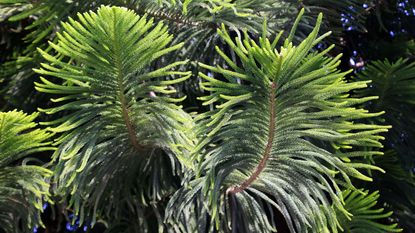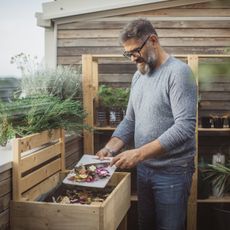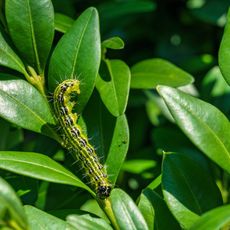Norfolk Island Pine Problems: Tackle Norfolk Island Pests & Diseases
While Norfolk pine can be a dream to grow both outdoors and inside, it is prone to pests and diseases. We outline the best ways to tackle (and prevent) key Norfolk Island pine problems


While the Norfolk pine tree (Araucaria heterophylla) may seem cute and unassuming, Norfolk Island pine problems crop up all too frequently. ‘Pine’ must be taken with a grain of salt, as these are warmth-loving tropical plants that grow in the wild in the Norfolk Islands of Australia. Growing in nature in the southern hemisphere, these trees grow to 200ft (610m) tall. However, as a potted plant or a garden tree in warm climates, it will stay a whole lot shorter.
In the main, caring for Norfolk Island pine is not overly complicated. They are not delicate and can even be an easy-care houseplant with the appropriate cultural care. But that’s not to say there are never any Norfolk Island pine pests or other problems. It’s important to take action if you see signs of Norfolk Island pine pest damage.
Why is My Norfolk Island Pine in Trouble?
Some plants just seem destined to be plagued by pests. Norfolk Island pines do have fairly rigorous cultural care requirements that must be met for them to remain lovely. Keep in mind that these plants are native to the rainforests of the South Pacific, which suggests the type of atmosphere in which they can thrive. Improper temperature, fertilizer, irrigation, humidity, sunlight and drainage can result in the browning or yellowing of foliage and dieback of lower branches.
Diseases and pests can also result in discolored needles, dying branches and generally poor development. In an appropriate hardiness zone and an environment with proper humidity and sunlight, outdoor plants may have fewer issues than indoor plants. On the other hand, they may also experience more insect pests.
Common Norfolk Island Pine Pests
- 1. Spider Mites: You may see tiny spider mites on Norfolk pine. Norfolk pine spider mites are tiny bugs that use their “beak” mouthpieces to suck out the sap from plant foliage. When Norfolk pine spider mites are an issue, you may see needles that are speckled with tiny beige spots, needles that look yellow or brown, or needles that fall. Look for fine webbing on the needles. This can turn the foliage from greenish-yellow and eventually tan or brown. Inspect the plant frequently for pests. If the infection is mild, a shower might help. There are several pesticides that can be helpful, as well as horticultural oil.
- 2. Scale: Another of the possible Norfolk Island pine pests is scale, another sap-sucking insect. This can lead to problems with sooty mold on the tree. Keeping the tree healthy is your best defense, giving it appropriate water and fertilizer. If the issue gets serious and you see yellowing and dropping needles, spray a summer oil to suppress the insects.
- 3. Sooty Mold: While not technically a Norfolk Island pine pest, sooty mold is a disease that can result from scale pest activities. Scale pests deposit honeydew as a secretion, and sooty mold is a type of mold that grows in the honeydew, causing the needles to look grimy. Get rid of the scales and the problem is solved.
Key Norfolk Island Pine Diseases
- Anthracnose: This is a potent fungal disease, Anthracnose best prevented by watering the plant without getting water onto the needles. You can look for dead needles with small back fungal bodies on them.
- Root Rot: In Norfolk pines, root rot can be caused by infected soil or overwatering. The Norfolk pine will grow slowly and wilt. If you dig to the roots, you will find them small, soft and dark. Avoid this serious disease by using pasteurized mix, keeping the soil moisture even, and using a protective fungicide.
- Yellowing: Does your plant look yellow instead of green? It could be yellowing, caused by a deficiency of micronutrients. Apply a micronutrient solution.
Other Likely Norfolk Pine Problems
- 1. Needles Falling Off: If this tropical plant doesn’t get enough humidity, the needles can start to drop. So if your Norfolk pine needles are falling off, add a humidifier in the room or at least a pebble tray with water.
- 2. Damage to Growing Tips: This is generally due to cold weather. Don’t leave the plant outdoors when temperatures drop to 45°F (7°C) or lower. Bring it inside the house or at least into the garage.
- 3. Dry and Brown Branches: These plants require adequate watering on a regular basis. If they get dehydrated, the lower branches will die. Be sure to water whenever the top soil is dry, but avoid overwatering, too.
Frequently Asked Questions
Why is My Norfolk Island Pine Drying Out?
Norfolk Island pines require water whenever their soil is dry, but the soil must offer excellent drainage. The trees also prefer very high humidity. You might consider a humidifier for an indoor houseplant.
How Do I Save a Dying Norfolk Island Pine?
The key to assisting any plant that appears distressed is to determine the cause. With these tropical trees, look first to cultural care and make sure your plant gets adequate sun, excellent drainage and proper fertilizer. They will not survive outdoors in cold temperatures.
Gardening tips, videos, info and more delivered right to your inbox!
Sign up for the Gardening Know How newsletter today and receive a free download of our most popular eBook "How to Grow Delicious Tomatoes."

Teo Spengler has been gardening for 30 years. She is a docent at the San Francisco Botanical Garden. Her passion is trees, 250 of which she has planted on her land in France.
-
 Urban Composting Guide: How To Compost In The Middle Of The City
Urban Composting Guide: How To Compost In The Middle Of The CityUrban composting does not have to be daunting. You can compost in the city, and maybe even try some urban worm composting!
By Mary Ellen Ellis
-
 Shrub Diseases And Pests To Watch Out For
Shrub Diseases And Pests To Watch Out ForShrub diseases and pests can be challenging. Learn how to recognize and eradicate them before they can present a danger to your plants.
By Susan Albert